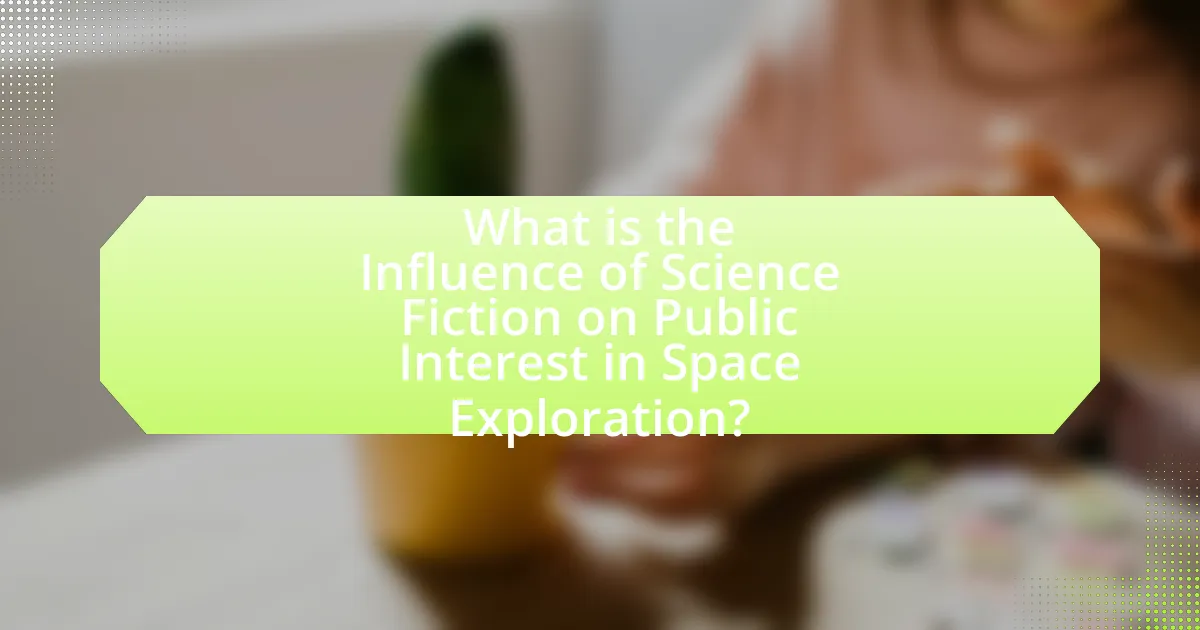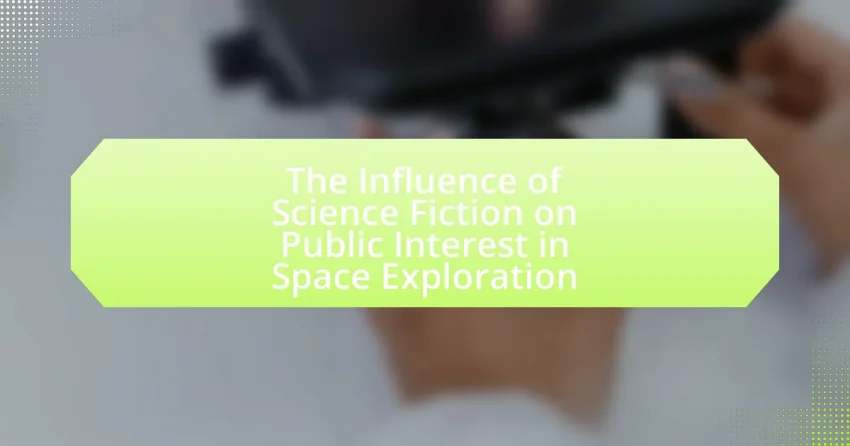The article examines the significant influence of science fiction on public interest in space exploration. It highlights how iconic works, such as “2001: A Space Odyssey” and the “Star Trek” franchise, have shaped perceptions and inspired curiosity about the cosmos, leading to increased public engagement and support for space missions. The article discusses key themes in science fiction that resonate with space exploration, the historical connections between the genre and actual space initiatives, and the impact of popular films on public enthusiasm and funding for space programs. Additionally, it explores how contemporary narratives continue to address challenges in space travel and the role of educational programs that utilize science fiction to foster interest in STEM fields.

What is the Influence of Science Fiction on Public Interest in Space Exploration?
Science fiction significantly influences public interest in space exploration by shaping perceptions and inspiring curiosity about the cosmos. Iconic works, such as Arthur C. Clarke’s “2001: A Space Odyssey” and the “Star Trek” franchise, have popularized space travel concepts and technological advancements, leading to increased public engagement and support for space missions. For instance, a 2019 study published in the journal “Acta Astronautica” found that science fiction narratives can enhance public understanding of space science and stimulate interest in real-world space initiatives, as evidenced by the surge in enrollment in STEM fields following the release of popular space-themed films. This connection between science fiction and public enthusiasm for space exploration demonstrates how storytelling can drive societal interest and investment in scientific endeavors.
How has science fiction shaped public perceptions of space exploration?
Science fiction has significantly shaped public perceptions of space exploration by popularizing the concept and inspiring curiosity about the universe. Iconic works, such as Arthur C. Clarke’s “2001: A Space Odyssey” and the “Star Trek” series, have introduced audiences to advanced technologies and the possibilities of interstellar travel, fostering a sense of wonder and ambition regarding space. These narratives often depict space exploration as a noble endeavor, encouraging public support for real-world missions, such as NASA’s Apollo program, which was influenced by the optimistic visions of space travel presented in science fiction. Furthermore, studies indicate that exposure to science fiction can enhance interest in STEM fields, as it stimulates imagination and encourages young people to pursue careers in science and engineering, ultimately contributing to advancements in actual space exploration efforts.
What are the key themes in science fiction that resonate with space exploration?
Key themes in science fiction that resonate with space exploration include the quest for knowledge, the consequences of technological advancement, and the exploration of humanity’s place in the universe. The quest for knowledge is often depicted through narratives that emphasize the drive to discover new worlds and understand the cosmos, as seen in works like Arthur C. Clarke’s “2001: A Space Odyssey.” The consequences of technological advancement are explored through cautionary tales about the potential dangers of space travel and artificial intelligence, exemplified in Isaac Asimov’s “Foundation” series. Additionally, the exploration of humanity’s place in the universe raises philosophical questions about existence and identity, as illustrated in films like “Interstellar.” These themes not only entertain but also inspire public interest in real-world space exploration initiatives, as evidenced by the increased engagement in space programs following the popularity of science fiction media.
How do fictional narratives influence real-world aspirations for space travel?
Fictional narratives significantly influence real-world aspirations for space travel by inspiring public interest and shaping perceptions of what is possible. For instance, films like “Star Trek” and “Interstellar” have not only entertained audiences but also sparked curiosity and ambition regarding space exploration, leading to increased support for space programs. Research conducted by the National Aeronautics and Space Administration (NASA) indicates that science fiction can enhance public engagement with space science, as it often presents futuristic technologies and scenarios that resonate with people’s imaginations. This connection between fiction and aspiration is evident in the rise of private space companies, such as SpaceX, which have been motivated by the visionary ideas presented in popular media.
Why is public interest in space exploration important?
Public interest in space exploration is important because it drives funding, innovation, and public support for space missions. When the public is engaged and excited about space, governments and private organizations are more likely to allocate resources towards research and development. For instance, NASA’s budget has historically seen increases during periods of heightened public interest, such as after significant space events like the Apollo moon landings. Additionally, public enthusiasm can lead to increased participation in STEM education and careers, fostering a new generation of scientists and engineers. This cycle of interest and investment ultimately propels advancements in technology and knowledge, benefiting society as a whole.
What role does public interest play in funding and supporting space missions?
Public interest significantly influences the funding and support of space missions by driving governmental and private investment. When the public expresses enthusiasm for space exploration, it often leads to increased budget allocations from governments, as seen with NASA’s funding, which rose to $23.3 billion in 2021, partly due to public interest in missions like Mars exploration. Additionally, private companies, such as SpaceX, leverage public interest to attract investment and sponsorship, evidenced by their successful fundraising efforts that have reached billions, enabling ambitious projects like the Starship program. Thus, public interest acts as a catalyst for both governmental and private sector funding in space missions.
How does public enthusiasm affect policy decisions regarding space exploration?
Public enthusiasm significantly influences policy decisions regarding space exploration by shaping funding priorities and legislative support. When the public expresses strong interest in space missions, policymakers often respond by allocating more resources to space agencies, as seen with NASA’s increased budget during periods of heightened public interest, such as after the release of popular science fiction films. For instance, following the success of movies like “Interstellar” and “The Martian,” public enthusiasm surged, leading to discussions in Congress about expanding NASA’s budget and initiatives. This correlation demonstrates that public sentiment can directly impact the direction and scale of space exploration efforts.

What are the historical connections between science fiction and space exploration?
Science fiction has historically influenced space exploration by shaping public imagination and inspiring scientific advancements. Early works, such as Jules Verne’s “From the Earth to the Moon” (1865) and H.G. Wells’ “The First Men in the Moon” (1901), introduced concepts of space travel that captured the public’s interest and laid the groundwork for future exploration. These narratives not only entertained but also prompted scientists and engineers to consider the feasibility of space travel, leading to real-world developments in rocketry and aerospace technology. The space race of the 20th century, particularly during the 1960s, saw a surge in science fiction literature and films, such as Arthur C. Clarke’s “2001: A Space Odyssey,” which further fueled public enthusiasm and support for missions like Apollo 11. This interplay between science fiction and actual space missions demonstrates how speculative narratives can drive technological innovation and public engagement in space exploration.
How did early science fiction influence the space race?
Early science fiction significantly influenced the space race by shaping public imagination and interest in space exploration. Works by authors like Jules Verne and H.G. Wells introduced concepts of space travel and advanced technology, which inspired both scientists and the general public. For instance, Verne’s “From the Earth to the Moon” depicted a lunar mission that predated actual space exploration efforts, while Wells’ “The First Men in the Moon” explored themes of extraterrestrial life and advanced propulsion systems. These narratives not only captivated audiences but also motivated government and private sector investments in space technology, culminating in the U.S. and Soviet Union’s competitive efforts to achieve space milestones during the Cold War. The excitement generated by these stories contributed to a cultural environment that prioritized scientific advancement and exploration, ultimately leading to significant achievements such as the launch of Sputnik in 1957 and the Apollo moon landing in 1969.
What notable works of science fiction emerged during the space race era?
Notable works of science fiction that emerged during the space race era include “The Martian Chronicles” by Ray Bradbury, published in 1950, and “Fahrenheit 451,” also by Bradbury, which reflects societal concerns during that time. Additionally, Arthur C. Clarke’s “2001: A Space Odyssey,” released in 1968, was significant for its exploration of space travel and artificial intelligence. These works not only captured the imagination of the public but also mirrored the technological advancements and anxieties of the era, as the United States and the Soviet Union competed for dominance in space exploration.
How did these works reflect societal attitudes towards space exploration?
These works reflected societal attitudes towards space exploration by portraying both the optimism and fears associated with humanity’s venture into the cosmos. For instance, during the 1960s, science fiction literature and films, such as “2001: A Space Odyssey,” illustrated a hopeful vision of space travel, aligning with the public’s excitement surrounding the Apollo missions and the Space Race. Conversely, works like “The Martian Chronicles” by Ray Bradbury highlighted anxieties about colonization and the potential consequences of human actions in space, mirroring societal concerns about environmental degradation and ethical implications. This duality in representation demonstrates how science fiction not only inspired public interest but also provoked critical reflection on the implications of space exploration.
What impact did popular science fiction films have on public interest?
Popular science fiction films significantly increased public interest in space exploration by captivating audiences with imaginative portrayals of space travel and extraterrestrial life. For instance, films like “Star Wars” and “2001: A Space Odyssey” not only entertained but also inspired curiosity about the universe, leading to a surge in interest in real-life space missions and scientific endeavors. According to a study by the National Aeronautics and Space Administration (NASA), the release of such films often correlates with spikes in public engagement with space-related topics, as evidenced by increased attendance at planetariums and higher enrollment in astronomy courses following major sci-fi film releases. This demonstrates that popular science fiction serves as a catalyst for public fascination with space exploration, bridging the gap between entertainment and scientific inquiry.
Which films are considered pivotal in inspiring interest in space exploration?
Films that are considered pivotal in inspiring interest in space exploration include “2001: A Space Odyssey,” “Star Wars,” and “Interstellar.” “2001: A Space Odyssey,” directed by Stanley Kubrick and released in 1968, is often credited with its realistic portrayal of space travel and advanced technology, influencing public perception of space exploration. “Star Wars,” beginning in 1977, introduced a vast universe and imaginative concepts of space travel, captivating audiences and sparking interest in the possibilities of space. “Interstellar,” released in 2014, combined scientific theories with emotional storytelling, further engaging viewers in the complexities of space and time. These films have significantly shaped cultural attitudes toward space exploration and inspired generations to consider the possibilities beyond Earth.
How do visual representations of space in films affect public perception?
Visual representations of space in films significantly shape public perception by creating emotional connections and stimulating interest in space exploration. For instance, films like “Interstellar” and “The Martian” have portrayed space as both a vast frontier and a place of human potential, influencing audiences’ views on the feasibility and excitement of space travel. Research indicates that such cinematic portrayals can increase public support for space missions; a study by the Pew Research Center found that 61% of Americans expressed interest in space exploration after viewing films that depict it positively. This demonstrates that visual storytelling in cinema not only entertains but also informs and inspires public attitudes toward real-world space initiatives.

How does contemporary science fiction continue to influence space exploration?
Contemporary science fiction significantly influences space exploration by shaping public imagination and inspiring technological advancements. Works such as “The Martian” by Andy Weir and the “Interstellar” film have popularized concepts like Mars colonization and advanced space travel, leading to increased interest and investment in these areas. For instance, NASA’s Artemis program, aimed at returning humans to the Moon, has been partly motivated by the cultural narratives established in science fiction, which envision human life beyond Earth. Additionally, the portrayal of space exploration in media has encouraged private companies like SpaceX to innovate and pursue ambitious goals, such as interplanetary travel, reflecting the aspirations depicted in contemporary science fiction.
What are the current trends in science fiction related to space exploration?
Current trends in science fiction related to space exploration include a focus on realistic portrayals of space travel, the ethical implications of colonization, and the integration of advanced technologies such as artificial intelligence and biotechnology. These trends reflect a growing interest in the scientific accuracy of space narratives, as seen in works like “The Martian” by Andy Weir, which emphasizes realistic survival techniques on Mars. Additionally, themes of sustainability and the consequences of human actions on other planets are increasingly prevalent, as illustrated in the series “The Expanse,” which explores the socio-political dynamics of a colonized solar system. These narratives not only entertain but also engage the public in discussions about the future of humanity in space, thereby influencing interest in actual space exploration initiatives.
How do modern narratives address the challenges of space travel?
Modern narratives address the challenges of space travel by exploring themes such as isolation, technological limitations, and the psychological effects on astronauts. For instance, films like “Interstellar” and series like “The Expanse” depict the vastness of space and the emotional toll it takes on characters, highlighting the mental health challenges faced during long missions. Additionally, these narratives often incorporate realistic scientific principles, such as the effects of time dilation and the need for sustainable life support systems, which reflect current research in space exploration. By presenting these challenges in a relatable manner, modern narratives engage the public’s interest in the complexities of space travel and the necessity for advancements in technology and human resilience.
What role do emerging technologies play in shaping science fiction narratives?
Emerging technologies play a crucial role in shaping science fiction narratives by providing the imaginative framework and context for storytelling. These technologies, such as artificial intelligence, virtual reality, and biotechnology, serve as catalysts for exploring complex themes and ethical dilemmas within the genre. For instance, the rise of AI has led to narratives that question the nature of consciousness and humanity, as seen in works like “Neuromancer” by William Gibson, which popularized cyberpunk themes. Additionally, advancements in space exploration technologies have inspired stories that reflect societal aspirations and fears about the future of humanity in space, as demonstrated in films like “Interstellar,” which incorporates real scientific theories about black holes and time dilation. Thus, emerging technologies not only enrich the narrative landscape of science fiction but also influence public perception and interest in real-world scientific advancements.
How can science fiction be used as a tool for education and outreach?
Science fiction can be used as a tool for education and outreach by engaging audiences with imaginative narratives that explore scientific concepts and future possibilities. This genre stimulates interest in science and technology by presenting complex ideas in accessible and entertaining formats, thereby fostering curiosity and critical thinking. For instance, works like Arthur C. Clarke’s “2001: A Space Odyssey” and Andy Weir’s “The Martian” have inspired real-world advancements in space exploration and technology, demonstrating how speculative scenarios can motivate scientific inquiry and innovation. Additionally, educational programs that incorporate science fiction literature and films have been shown to enhance learning outcomes, as they encourage discussions about ethical implications and societal impacts of scientific advancements.
What educational programs utilize science fiction to engage students in space science?
Educational programs that utilize science fiction to engage students in space science include NASA’s “STEM on Station” and the “Mars Generation” initiative. NASA’s program incorporates science fiction narratives to inspire students through real-world applications of space science, while the Mars Generation uses science fiction themes to promote interest in space exploration and STEM careers. Both programs demonstrate the effectiveness of science fiction in making complex scientific concepts accessible and engaging for students, thereby fostering a deeper interest in space science.
How effective are these programs in fostering interest in STEM fields?
These programs are highly effective in fostering interest in STEM fields. Research indicates that exposure to science fiction, particularly through films and literature, significantly increases engagement and curiosity about science and technology among audiences. For instance, a study published in the journal “Science Communication” found that participants who engaged with science fiction narratives demonstrated a greater interest in pursuing STEM education and careers compared to those who did not. This correlation suggests that science fiction serves as a powerful tool in inspiring future generations to explore and enter STEM disciplines.
What practical steps can be taken to leverage science fiction for promoting space exploration?
To leverage science fiction for promoting space exploration, organizations can collaborate with authors and filmmakers to create engaging narratives that inspire public interest. These narratives can highlight the possibilities of space travel, technological advancements, and the importance of exploration for humanity’s future. For instance, the success of films like “Interstellar” and “The Martian” has demonstrated that compelling storytelling can significantly increase public enthusiasm for space missions, as evidenced by the rise in NASA’s social media engagement following such releases. Additionally, educational programs can incorporate science fiction themes to stimulate interest in STEM fields, encouraging the next generation to pursue careers in space exploration.
